What is the 2-3 zone defense in basketball
The 2-3 zone defense is a basketball defensive strategy that seeks to limit dribble penetration, influence contested perimeter jump shots, and decrease offensive scoring opportunities, particularly from the low post areas, while executing adequate on-ball defense.
What is an example of the initial formation for the 2-3 zone defense
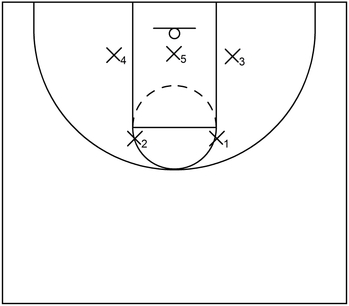
This is an example of the initial formation for the 2-3 zone defense that features two defenders at the front of the zone and three defenders in the back of the zone.
X1 and X2 start near the high post areas. X3 and X4 start near the low post areas while X5 starts inside of the lane in front of the basket.
What are the general responsibilities of the defenders within the 2-3 zone defense
The main responsibilities of X1 and X2 are to cover the wing and high post areas. The primary responsibilities of X3 and X4 are to cover the corners and the low post areas.
Additionally, X3 and X4 could temporarily cover the wing areas if ball reversal occurs from the right side wing to the left side wing. The typical responsibilities of X5 are to protect the basket and execute low post defense when necessary.
What are advantages of the 2-3 zone defense
One useful advantage of the 2-3 zone defense is that it could be possibly beneficial against offensive teams with less than average perimeter shooting skills.
Additionally, the 2-3 zone defense could also be somewhat advantageous against teams that prefer to generate points by passing the ball towards the low post area.
This is significant because if the offensive team passes the ball near the low post, then two of the zone defenders could double team the low post player.
If that happens, then the low post player would most likely pass the ball to another teammate, preferably near one of the perimeter areas of the court.
Another notable advantage of the 2-3 zone defense is that it is versatile enough to provide adequate defensive coverage against the perimeter as well as the low post area.
In other words, there will typically be at least one defender that can quickly cover the wing, corner or low post area, even if the zone shifts from side to side by way of offensive ball movement.
What are disadvantages of the 2-3 zone defense
The primary disadvantage and overall weakness of the 2-3 zone defense is that the high post area is vulnerable due to the gap in the middle of the zone.
Therefore, if the offensive team successfully passes the ball into the high post area, then the zone would be effectively broken.
Once that occurs, the offensive team could quickly create scoring opportunities from the high post area, especially with high low action or by passing the ball to potential perimeter shooters near the wings or corners.
So, to avoid this situation, it is absolutely necessary for the zone defenders, specifically at the front of the zone, to guard the high post with vigilance.
Other noteworthy disadvantages of the 2-3 zone are that it is susceptible to perimeter ball reversal by the offensive team, particularly near the wings, and it is usually not very effective against offensive teams with multiple three-point shooters.
In other words, a team with multiple three-point shooters can simply reverse the ball along the perimeter and eventually wait for an opening to shoot three-pointers as the zone shifts from side to side.
What are key principles to consider for the 2-3 zone defense
Limit or prevent low post touches
If the ball gets into the hands of a low post player with above average offensive skills, then that player could score quickly and efficiently against the nearest zone defender with a low post move.
Therefore, the strong side defenders near the back of the zone could alleviate this problem by standing in the gap between the low post area and the wing/corner.
This will increase the difficulty for the offensive team to make an easy entry pass to the low post player.
Limit or prevent uncontested jump shots
One of the main purposes of the 2-3 zone, like most zone defenses, is to influence perimeter jump shots. However, this does not automatically mean that offensive players should be able to freely take uncontested jump shots.
Instead, the defenders of the 2-3 zone defense should always try to closeout with good footwork and contest jump shots, even from below average shooters.
This is especially important for the defenders near the low post areas in the back of the zone. These defenders should emphasize executing good closeouts to prevent wide open jump shots.
Box out for defensive rebounds
Teams that run the 2-3 zone defense (and zone defense in general) do not guard specific players. Therefore, it is important for the zone defenders to box out properly when a player on the offensive team attempts a field goal.
This is particularly essential on long rebounds, which typically occur when the offensive team shoots a perimeter shot such as a three-pointer. Basically, missed perimeter jump shots will typically bounce long and away from the basket.
When that occurs, if the zone defenders do not box out properly (or at all), then the team on offense will have the opportunity to gain an offensive rebound and this in turn, could lead to second chance scoring opportunities.
Use bumping during ball reversal
As mentioned previously, one of the primary disadvantages of the 2-3 zone defense is its susceptibility to perimeter ball reversal. However, the zone defenders could mitigate this problem to a degree by executing a technique known as bumping.
Essentially, when the ball gets reversed from wing to wing, one of the zone defenders in the front, which typically covers the wing, will usually not have enough time to recover.
If that occurs, then this could lead to wide open perimeter jump shots or possible dribble penetration into the zone.
However, to counter that action by the offensive team, one of the zone defenders near the low post areas can step up towards the wing to cover that area for about a second or two until the respective zone defender in the front can recover and bump that back side defender to their original zone area.
Affiliate Disclosure: I may earn a commission on qualifying purchases made through the links below.
What are examples of defensive rotations for the 2-3 zone defense
Example 1

This is an example of the 2-3 zone defense when the ball is at the top. X1 and X2 will cover the high post areas and deny any potential entry passes into the high post.
At the same time, X3 and X4 will cover the low post areas while X5 stands in front of the basket.
Example 2

This is an example of the 2-3 zone defense when the ball is on the wing. X1 slides over to cover 2 while X2 slides over to cover the high post and deny any potential entry passes.
At the same time, X3 stands in the gap between the low post and the corner. At the same time, X4 covers the weak side low post area. Additionally, X5 covers the low post player and could front to deny the low post entry pass.
Example 3

This is an example of the 2-3 zone defense when the ball is in the corner. X3 executes a closeout to prevent an open jump shot or dribble penetration.
Additionally, X1 covers the wing while X2 covers the high post. X4 continues to cover the weak side low post while X5 continues to guard the low post player.
Example 4 – Part 1
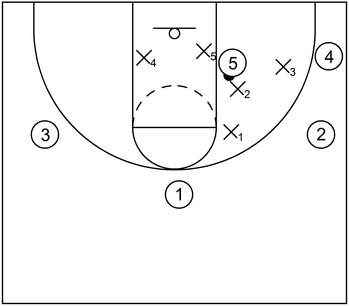
This is an example of a 2-3 zone defense variation that features a double team in the low post derived from Notre Dame’s 2-3 Zone Defense with Coach Muffet McGraw.
When the ball gets into the low post, X5 plays behind and takes away the baseline near the low side.
At the same time, X2 quickly drops back to help double team the ball near the high side. Also, X4 protects the basket from potential weak side cutting action by 1 or 3.
Example 4 – Part 2
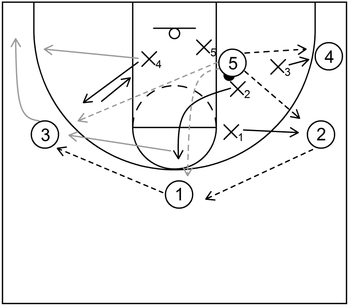
This part of the example demonstrates potential passing options that could occur out of the low post double team and how the zone defenders should rotate accordingly.
If 4 receives the ball from 5, then X3 should quickly closeout towards the ball and contest the jump shot if necessary. If 2 receives the ball from 5, then X1 should closeout and contest the jump shot if necessary.
Furthermore, if 1 receives the ball from either 5 (gray dotted arrow) or 2, then X2 should sprint to closeout with the possible contest if necessary.
Similarly, if 3 receives the ball from either 5 (gray dotted arrow skip pass) or 1, then X4 should step up to cover the left side wing area and after that, X2 should closeout towards the left side wing (gray solid arrow) and then bump X4 back to the left side low post area.
Additionally, if 3 flattened out to the left side corner (solid gray arrow) and received the skip pass from either 5, 2, or 1 (pass not shown on diagram), then X4 should closeout and contest if necessary (solid gray arrow).
What are examples of breakdown drills for the 2-3 zone defense
Drill #1
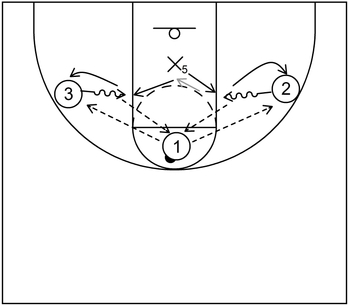
This is a 2-3 zone defense drill derived from 2-3 Zone Defense – Scouting Adjustments and Breakdown Drills by Coach Mike Hopkins.
This drill is for X5 and its main purpose is to improve footwork and stop potential middle penetration. The setup features three offensive players; one above the free throw line and two inside the three-point arc slightly below the free throw line extended.
At the start before 1 executes the pass, X5 should be in the proper defensive stance and chop (or slightly bounce) the feet in place ready to move to the left or right. Next, 1 picks either side to execute the pass. For this example, 2 receives the ball from 1.
After that, 2 quickly tries to dribble towards the middle of the lane. When that happens, X5 has to quickly sprint to cut off the penetration by 2. If X5 is quick enough, then X5 should try to keep 2 from touching the paint altogether.
However, if X5 is not quick enough, then X5 should try to force 2 to dribble back towards the high post by using length, size, and footwork without fouling.
In either case, once X5 stops the dribble penetration, 2 should reverse the ball back to 1 and backpedal to the initial right side wing area. Following that, X5 temporarily drops back to the initial spot in front of the basket show with the gray arrow.
Next, 3 receives the ball from 1 and when that occurs, 3 quickly tries to dribble into the middle. X5 has to once again sprint to cut off the dribble penetration of 3.
Afterwards, 3 reverses the ball again to 1, returns to the initial spot on the left side wing, and at the same time, X5 drops back to the initial area in front of the basket.
From this point, 2 would receive the ball again from 1 and the drill would continue as before. This drill could be executed for either a certain number of repetitions or a certain amount of time depending on the coaching staff’s preference.
Drill #2 – Part 1
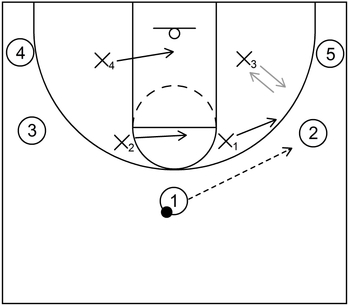
This drill for the 2-3 zone defense features four of the zone defenders near the high/low post areas and its objective is to improve the closeout technique near the wings and corners.
Furthermore, the offensive team is set up in a 5 out formation and these players can drive to the basket or shoot jump shots if open.
Although, it should be noted that offensive actions should only happen after a certain number of passes occur or after a specific amount of time has passed.
Additionally, if the offensive team makes a field goal, then the offense wins the drill. However, if the offensive team misses a field goal attempt, then the defense wins the drill.
After the winner has been determined, the players can switch sides : offense to defense and defense to offense.
To start, 2 receives the ball from 1 and that influences X3 to temporarily guard 2. As that occurs, X1 sprints to the right side wing and bumps X3 to the back of the zone, shown with the gray arrows.
Also, X2 slides over towards the high post area while X4 slides over into the lane to protect the basket from potential weak side cutting action.
Drill #2 – Part 2
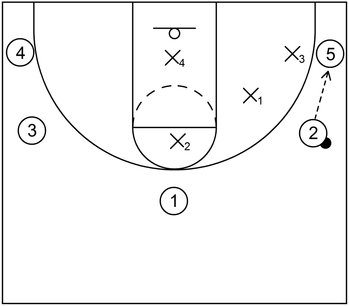
Next, 5 receives the ball from 2 and this triggers a closeout by X3 towards the right side corner. At the same time, X1 drops back to stand in the gap between the wing and corner in anticipation of a middle dribble drive or to closeout on 2.
Also, X2 continues to cover the high post while X4 continues to protect the basket.
Drill #2 – Part 3
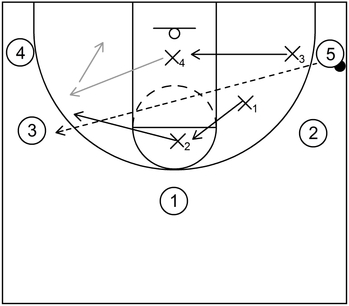
Following that, 3 receives a skip pass from 5. When that occurs, X4 temporarily executes a closeout to 3.
As that happens, X2 recovers to the left side wing and bumps X4 to the original area in the back of the zone. Also, X1 cuts to the high post area while X3 cuts into the lane to protect the basket.